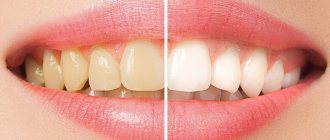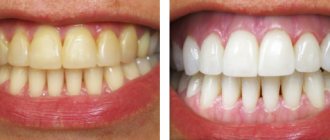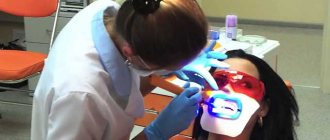A beautiful snow-white smile always decorates, so many people decide to lighten their tooth enamel. The teeth whitening procedure is performed by a professional in a dental office, but you can also try home methods, which are often just as effective. However It is advisable to give preference to those methods that do not harm tooth enamel and health.
Main indications for whitening
Usually, enamel is lightened for only one purpose - to give it an aesthetic appearance. Yellow teeth with plaque cause discomfort; a person with an ugly smile may develop complexes that prevent full communication with people.
Sometimes doctors recommend a whitening procedure. For example, in cases where the client requires dental restoration or prosthetics. Thanks to preliminary cleaning of the tooth surface from deposits and stones, the dentist will be able to choose the optimal color of the crown or filling. Fillings installed after professional cleaning are completed last longer and cause fewer problems.
Professional whitening
If you look at the photo showing teeth before and after whitening in a dental clinic, it becomes clear that going to a specialist gives a guaranteed result. A professional enamel lightening procedure involves influencing dentin with special active substances-agents, due to which teeth become lighter by up to 12 tones.
Professional teeth whitening: before and after photos
The teeth whitening procedure at the dentist most often occurs in several stages:
- Application of special professional bleaches.
- Enhancing the activity of the applied composition by heating the tooth surface with a laser or a special lamp.
- Washing the reagent with water.
- Coating the dentition with a protective fluoride-containing varnish.
The duration of professional whitening ranges from 30 minutes to 2 hours, that is, the effect will be achieved in just one session with the dentist.
Types of teeth whitening in dentistry
- Laser. Using a laser, you can lighten tooth enamel to a color pre-selected by your doctor.
- Chemical. Chemical whitening involves the use of special pastes with a pronounced abrasive effect.
- Mechanical. Lightening by brushing teeth. For this, different methods are used: ultrasound, toothpaste, pharmaceutical preparations based on activated carbon, powders, etc. This method helps if dark plaque on the enamel appears from frequent consumption of caffeine-containing drinks, smoking, or after wearing braces for a long time.
- Endobleaching. The method consists of cleaning the mouths of the root canals from the old filling and applying a whitening gel to the coronal part. It is used for teeth with removed roots and filled root canals, as well as in cases where several external lightening procedures have failed.
- Photobleaching. A special gel containing hydrogen peroxide is applied to the enamel. This gel is then shined with a halogen lamp, which releases active oxygen, which pushes pigments out of the tooth and discolors them. From time to time the procedure has to be repeated.
Lightening enamel at home
At home, special pencils, strips, and pastes are used to whiten teeth, which are sold in pharmacies and regular stores. Some of them turn out to be quite effective. If you use such products for a long time, you can get rid of yellow plaque, and sometimes lighten your teeth a couple of shades.
For example, with the help of whitening strips you can make your smile snow-white in just 2-3 weeks , the effect will last for 3-4 months. A dental pencil is an analogue of a lightening gel. Its advantage is the convenience of applying the active substance to problem areas. Whitening paste will be effective only if a person has chosen the right toothbrush and brushes his teeth for a long time.
Products available to the average consumer should be used with caution. Teeth whitening at home often leads to increased sensitivity of the gums.
You shouldn’t expect quick results from such manipulations; in one day you can whiten the surface of a tooth on your own only with the help of preparations whose components do not clean, but paint the enamel white.
The most popular and safest way to whiten teeth at home is to use baking soda. You just need to add sodium bicarbonate to toothpaste, apply it to a regular toothbrush and clean the enamel.
Ash and activated carbon remove plaque quite well in hard-to-reach places. But with the help of these products you can achieve a minimal whitening effect: after several months of regular use, the enamel will become lighter by just a couple of tones.
Interincisal angles.
Interincisal angles are the spaces between the cutting edges of the anterior group of teeth.
With the harmonious construction of teeth, these angles should gradually increase from the center to the periphery: from a small closed angle between the central incisors, to a more direct and even open angle between the 2nd and 3rd teeth.
Tooth wear leads to a decrease or complete absence of interincisal angles, which makes the patient look older when he smiles.
At the same time, “female” teeth are characterized by rounded corners of the incisors, while “male” teeth are characterized by straighter ones.
Application of silicone mouth guards
The teeth whitening procedure using silicone aligners deserves special attention. This process is carried out in several stages:
- The dentist takes an impression of the oral cavity.
- Production of individual silicone trays in the laboratory.
- Filling the tray with a special gel. Unlike concentrated professional products, gels with low acid concentration are used at home.
- The patient uses a prepared structure according to a special scheme. The mouthguard is worn every day, following the instructions and gradually increasing the wearing time.
- At the end of the treatment session, the oral cavity is cleaned of any remaining gel and rinsed thoroughly.
The condition of the tooth enamel will become noticeably better within a week after starting to wear the mouth guard, but to get a snow-white smile, a course lasting 25–30 days is required.
Parallelism of horizontal landmarks.
One of the most important signs of a harmonious smile is the parallelism of imaginary lines: the interpupillary line (in the picture there is a blue line connecting the right and left pupil of the eye) and the lip line (in the picture there is a red line drawn between the corners of the mouth).
Both of these lines should also be parallel to the lines connecting the edges of the central incisors (green) and the incisal cusps of the canines (blue)
Features of whitening procedures at home
There are some nuances that must be taken into account when lightening tooth enamel yourself:
Before and after teeth whitening with baking soda at homeIf in any good clinic in Moscow whitening can be done in one visit to the doctor, then at home it will take much longer: several weeks or even months.
- You will have to do all the manipulations yourself, and this is not so easy. For household use, it is recommended to use less aggressive materials: the same gel should be at least 2–3 times less concentrated than a professional one . And still, before applying the product, you need to make sure that the active substance does not get on the gums, as it can damage the mucous membranes.
- Before carrying out the procedure, consultation with a specialist is required. Only a doctor can adequately assess the extent of the problem and select an effective remedy. All actions before and after teeth whitening should be carried out under the constant supervision of a dentist.
What it is
In fact, the terms “photo bleaching” or “light bleaching” are not entirely accurate. The light itself has no effect on tooth enamel and is not able to in any way affect its color. The technique is based on an active chemical reaction in which light radiation is only a catalyst that stimulates the production of teeth-lightening reagents. The main bleaching agent most often is hydrogen peroxide in high concentration, from which, under the influence of light or ultraviolet radiation, a highly active form of oxygen is formed, which penetrates the dental tissue and whitens them.
Varieties:
- LED is the safest, since LEDs do not produce a thermal effect on the teeth.
- Halogen - a lamp with a halogen emitter is used, which provides minimal heating of tissues.
- Ultraviolet is the most intense type of ultraviolet whitening, accompanied by significant heat generation and heating of the teeth.
Consolidate the result
The teeth whitening procedure is carried out at intervals from 6 months to 2 years. To reduce the number of sessions, you should take all preventive measures recommended by your dentist.
You can maintain the whiteness of your tooth enamel after completing the whitening procedure by:
- using high-quality and effective toothpastes that are designed to care for the entire oral cavity;
- removal of dental plaque in the clinic several times a year (preferably every 4 months);
- limited consumption of products that contain coloring pigments: strong tea, black coffee;
- quitting smoking cigars, cigarettes, hookah.
Possible complications
Most often, negative consequences occur after home whitening. Most people, in pursuit of a beautiful Hollywood smile, do not follow the recommendations for the use of certain products - and their teeth acquire an uneven color.
Another reason why you should consult a dentist before lightening your tooth enamel is the presence of fillings. Only a doctor can predict the reaction of the filling to the bleaching gel reagent and, taking this into account, choose the drug correctly. Otherwise, the material may darken, which will ruin the appearance of the enamel.
It is worth mentioning in the article that the active components of bleaching products can burn the mucous membrane . The possibility of an allergic reaction, increased sensitivity of the gums, and other unpleasant sensations cannot be excluded.
Usually all pathological manifestations go away on their own within a few days. If this does not happen, you should consult a doctor as soon as possible.
How much does a Hollywood smile cost?
It is impossible to answer definitively the question of how much it will cost to create a Hollywood smile. It all depends on the source data. Doctors of different specialties often participate in the work - therapists, hygienists, orthodontists, orthopedists, implantologists. The better the condition of your teeth and oral cavity, the cheaper a perfect smile will cost. In rare cases, all procedures end with professional hygiene and whitening.
Additional treatment always increases costs. The final cost of a beautiful smile is determined by several factors:
- Type of treatment;
- Volume of medical procedures;
- Technologies used;
- Types of orthopedic and orthodontic structures used, etc.
To find out the exact cost of your new smile, come for a consultation with a dentist at our clinic. If necessary, the doctor will refer you for examination and consultation with specialized specialists. After this, we will be able to calculate the prices of all procedures necessary to create a Hollywood smile.
Contraindications
It is not recommended to whiten your teeth:
- children and adolescents under 18 years of age;
- pregnant women and mothers during lactation;
- persons with cancer;
- patients with diabetes mellitus;
- while taking potent medications;
- if there are crowns or a large number of fillings on the outside of the dentition;
- if there is carious damage to the enamel or problems with the gums;
- people allergic to citric acid, baking soda, hydrogen peroxide, and other bleaching agents.
Teeth whitening is not a harmless procedure at all. It should be approached with the utmost caution and responsibility. It is best to entrust this process to a good specialist.
Vertical symmetry and midline.
A line passing through the center of the face should pass exactly between the central incisors of the upper jaw. The discrepancy between these lines causes a feeling of disharmony even with a quick glance at your smile from the outside. In this case, it is not at all necessary that it also passes between the central lower incisors. Firstly, a complete match is rarely found, and secondly, this in no way affects the aesthetic perception of your smile when viewed from the outside.










